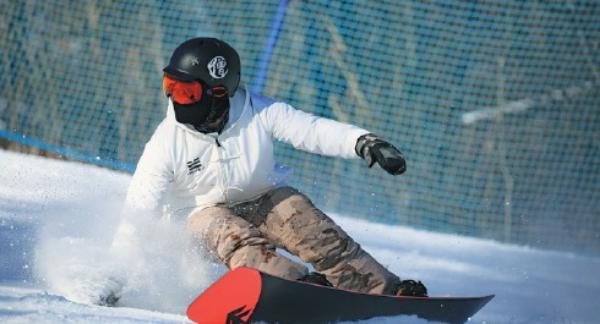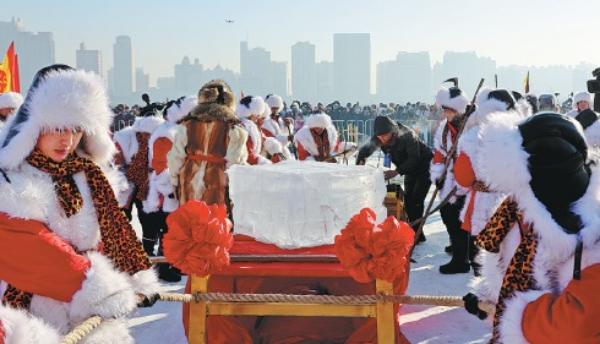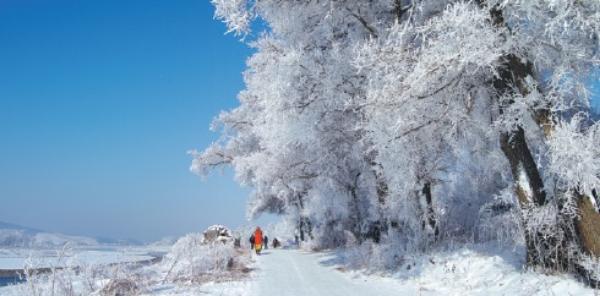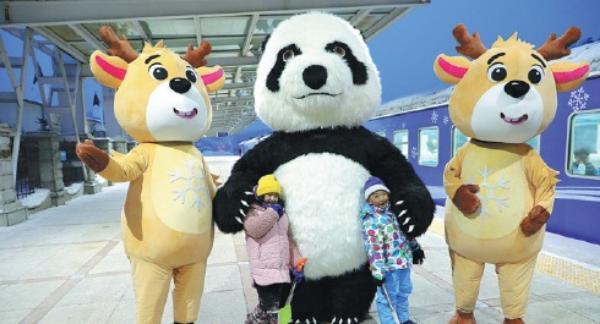 A snowboarder practices at Wanda White Mountain Resort in Baishan city, Jilin province. (PHOTO / CHINA DAILY)
A snowboarder practices at Wanda White Mountain Resort in Baishan city, Jilin province. (PHOTO / CHINA DAILY)
To keep visitors safe from the coronavirus, Heilongjiang and Jilin provinces are developing new modes of experience, including online activities to supplement the traditional extravaganza of icy artwork.
The New Year comes with Northeast China's coldest days, but it's also peak season for winter tourism of both conventional and unconventional sorts.
With COVID-19 epidemic prevention and control in mind, Heilongjiang province is promoting a series of measures for the winter season that include the development of online tourism products, officials said recently.
"The cloud has become a new mode of tourism, as the accelerated construction of new infrastructure, including 5G and data centers, provides a new driving force," said Zhang Lina, head of Heilongjiang's culture and tourism bureau. "Since the spring of 2020, we have integrated pictures, videos, panoramic virtual reality and some other resources from all 13 cities in the province to launch a series with the theme 'Traveling in Heilongjiang online', which provides tourists with a new way to appreciate the beautiful scenery of our province without leaving home."
 Workers in traditional local costumes pull the first block of ice from the Songhua River in Harbin, Heilongjiang province, on Dec 7. The folk ceremony marks the start of the ice harvest season. (PHOTO / CHINA DAILY)
Workers in traditional local costumes pull the first block of ice from the Songhua River in Harbin, Heilongjiang province, on Dec 7. The folk ceremony marks the start of the ice harvest season. (PHOTO / CHINA DAILY)
"The province has also rolled out 15 winter tourism destinations and 10 ways for visitors to enjoy the winter there," Zhang said. "Tourists can ski or experience winter art, go sightseeing or hiking or fishing. They can soak in hot springs or take in folk customs and cultural performances during their stay. Heilongjiang is typically the first place in China to greet winter."
Tourists can only enter tourist attractions after booking online, and the number of tourists will be strictly limited," she said, adding that rated hotels and tourism accommodations are required to carry out regular disinfection.
According to a report released by Chinese travel website Mafengwo in December, the most popular winter tourism destination during the New Year's holiday is Harbin.
Themed "Harbin: The Pearl on the Crown of Ice and Snow", activities started in early November and will run until April, overlapping some of China's traditional holidays, said Li Geng, deputy director of the city's culture and tourism bureau.
 Rime on trees creates some spectacular natural scenery, turning Jilin city in Northeast China's Jilin province into a dreamy landscape. (PHOTO / CHINA DAILY)
Rime on trees creates some spectacular natural scenery, turning Jilin city in Northeast China's Jilin province into a dreamy landscape. (PHOTO / CHINA DAILY)
A major draw for Harbin, known as "Ice City", is its more than 400 activities during the period. They cover tourism, culture, art, fashion, sports and trade, Li said.
The 22nd Harbin Ice and Snow World, a 600,000-square-meter wonderland of sculptures, opened on Dec 24 and will run until the end of February.
The park, an important element of the city's winter tourism season, has been an attraction for 21 consecutive years. It is built each winter with ice rather than commonly used construction materials.
As man-made ice often contains air bubbles and is not strong enough to carve, ice for the festival is harvested from the Songhua River, which runs through the city. Under the rules, each block of ice must be 80 centimeters wide, 40 cm thick and 120 cm long.
After the first block of ice was pulled from the frozen river on Dec 7, around 200,000 cubic meters of ice has been transformed into fanciful ice buildings and sculptures, making the park a winter wonderland.
Another important event in the city-the 33rd China Harbin Sun Island International Snow Sculpture Art Expo-kicked off on Dec 20 after three weeks of construction.
At the expo, which is located in Sun Island Park, tourists can view 50 groups of snow sculptures, which use more than 90,000 cubic meters of snow, including the 116-meter-long main snow sculpture The Chinese Dragon.
Several snow sculpture competitions will be held at the park during the expo, which will last until February.
With temperatures dropping to-40 C recently, Mohe, China's northernmost city, is also presenting its unique winter charms to tourists.
The city is one of the few places in China with a subarctic climate-long, severe winters and short, warm summers. Winter begins in early to mid-October and lasts until late April. It is the coldest place in China, holding the record for the lowest temperature, -52.3 C in 1956.
 Young tourists take photos with cartoon characters at the Harbin railway station before getting on the snow-themed train to Yabuli. (PHOTO / CHINA DAILY)
Young tourists take photos with cartoon characters at the Harbin railway station before getting on the snow-themed train to Yabuli. (PHOTO / CHINA DAILY)
Beiji Village, 88 kilometers from the city center, attracts virtually all visitors who land at Mohe. They visit China's northernmost bank and post office and experience traditional rural life in the Northeast.
In the village, a recently built hotel made of ice and snow has become a popular attraction. Almost everything inside is made of frozen water in some form, including the beds, tables, sofas and decorations.
Smonlin Igor, the 17th Santa Claus, arrived in China in November. He dressed up as the Jolly Old Elf and posed for photographs with tourists
The ice beds, in particular, are popular as people like to try out the frozen surface.
There is also the first Christmas village in Asia, which started in 2012. In the village, 25 km from the center of Beiji village, people from the town of Santa Claus, Finland, play various roles. They had to pass an examination to be selected.
READ MORE: Winter sports in limelight as firms anticipate growth opportunities
Smonlin Igor, the 17th Santa Claus, arrived in China in November. He dressed up as the Jolly Old Elf and posed for photographs with tourists. The greetings he wrote on postcards bore the signature "Santa Claus".
"It is really a unique experience of traveling from a place with temperatures of nearly 20 C to another place at lower than-30 C," said Qiao Ba, a tourist from Hainan province. "I was shocked when I entered the ice and snow world, and I believe I will never regret the visit here."
ALSO READ: Hebei moves aggressively to build winter sports
Jilin joins in
Neighboring Jilin province also boasts great advantages for winter tourism. It is loaded with venues and facilities, said Yang Andi, director of the provincial culture and tourism bureau, adding that the province has worked to develop its ice and snow industry in recent years.
Because of the COVID-19 pandemic, the province received only 2.19 million tourists last winter season, compared with the 2.95 million during 2018-19.
During this winter tourism season, which started in mid-November, nearly 300 snow-and ice-themed activities will be held across the province, offering a broad range of options for tourists.
The fifth Jilin International Ice and Snow Industry Expo was held from Dec 25 to Dec 29 in Changchun's capital, Jilin. Covering an area of 100,000 square meters, the expo featured nearly 80 museums and more than 400 enterprises.
As the only ice-and snow-themed expo in the country, the event promoted a combination of Winter Olympics themes, winter culture, ice and snow tourism and winter sports in Jilin.
On Dec 18, the 26th International Rime Ice and Snow Festival kicked off in Jilin. Trees in areas along the Songhua River and Rime Island will be covered by a special type of frost resembling granular tufts of ice. These occur only under specific climatic conditions in which warm, moist air rises from the river and freezes as it encounters the cold air above.
The best time for tourists to observe this spectacular phenomenon in the city is between November and February.
Fish of fortune
Every winter on the frozen Chagan Lake, an impressive winter fishing ritual that dates to the Jin Dynasty (1115-1234) takes place.
The first catch of the season-a 23-kilogram fish-set an auction record of 2,999,999 yuan at the opening ceremony of the 19th Chagan Lake Fishing and Hunting Cultural Tourism Festival on the lake.
The buyer, the Zhejiang Chamber of Commerce in Jilin province, paid the record sum as a donation to support the continued maintenance of the lake, including protecting its water quality and stocking it with fry, according to Shan Guojun, Party secretary of the Chagan Lake fishery.
A group of fishermen worked together to cast thousands of meters of nets through holes they had drilled in the ice on the frozen lake's surface early one morning.
Several hours later, the nets, bulging with fish, was winched out by horses walking around a mechanical wooden capstan.
The traditional skills of Chagan Lake winter fishing were listed as an intangible cultural heritage in 2008.
Such activities, including the Jilin Rime Ice and Snow Festival, the Chagan Lake Fishing and Hunting Cultural Tourism Festival and the Jingyuetan Vasa International Skiing Festival, have built Jilin's brand. Its ice and snow exhibition and other activities have marked an integrated path in the development of cultural tourism, Yang said.


